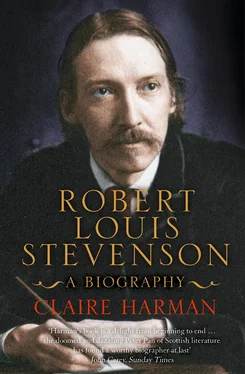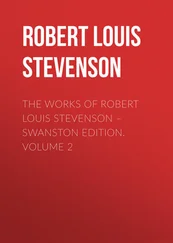Frances Sitwell was thirty-four when she met Stevenson, and had been married since the age of twenty to the Reverend Albert Sitwell, sometime private secretary to the Bishop of London and vicar of Minster, in Kent, since 1869. They had met in Ireland, where both grew up, and spent the earliest part of their marriage in India; Frances had also lived in Australia. The marriage was not a success, at least not from Mrs Sitwell’s point of view. No one seems to have had a good word to say for her husband, ‘a man of unfortunate temperament and uncongenial habits’, according to E.V. Lucas. 36 The euphemism hints at cruelty and vice (was Sitwell an adulterer? a drinker?), but all we can be sure of is that by the time the couple moved to Minster with their two little boys, Frederick and Bertie, Frances was finding it necessary to spend long periods of time away from home visiting friends, of whom Maud Babington was the closest. Like Louis, she was an exile at Cockfield from an intolerable home life.
When Stevenson met her in the summer of 1873, Mrs Sitwell was mourning the death of her elder son only three months before, aged twelve. The tragedy seems to have catalysed her thoughts about a permanent separation from her husband, though she knew it would be difficult to effect one without Sitwell’s agreement. She and her surviving son were tied to ‘the Vicar’ indefinitely unless she could become financially independent, which meant finding a job, a very daunting prospect for a woman of her social standing at the time.
One thing she didn’t consider, and which speaks volumes about her character, was to throw herself into the arms of one or other of her many admirers. They were, on the whole, adorers rather than suitors, in whom she inspired devotion that verged on idolisation. ‘Divining intuition like hers was genius. Vitality like hers was genius,’ one of them wrote; another, ‘she was the soul of honour, discretion and sympathy’, ‘waiting for her smile is the most delightful of anticipations, and when it comes it is always dearer than you remembered, and irradiates all who are in her company with happiness’. 37 Over the years she nurtured a string of needy young men, including Stevenson, Sidney Colvin, Cotter Morrison, Stephen Phillips and latterly Joseph Conrad, all of whom left ardent tributes to her virtues: a ‘good angel’, ‘a priceless counsellor’; a ‘deity’. 38 But above and beyond the superlatives, a genuinely extraordinary character emerges: not a wit, a beauty or a coquette, but a woman of quiet, tender and very ardent feelings, who retained a childlike capacity for simple pleasures and the subtlest appreciation of sophisticated ones. Colvin remembers her clapping her hands for joy and ‘leaping in her chair’ at the anticipation of a gift or treat, and described her sympathy thus: ‘She cools and soothes your secret smart before ever you can name it; she divines and shares your hidden joy, or shames your fretfulness with loving laughter; she unravels the perplexities of your conscience, and finds out something better in you than you knew of; she fills you not only with generous resolutions but with power to persist in what you have resolved.’ 39 It was this paragon with whom Stevenson spent the month of August 1873. Sibylline, sensitive, brave, tender, distressed, bereaved, abused: he would have fallen in love with a tenth of her.
Mrs Sitwell, as we have seen, was delighted by the young Scot and within three days of his arrival at Cockfield had written to her friend Sidney Colvin to urge him to hurry if he wanted to meet ‘a brilliant and to my mind unmistakable young genius’ 40 who had ‘captivated the whole household’ 41 at Cockfield. Colvin had been a friend of hers (how good a friend I will discuss presently) since the late 1860s. They probably met through the Babingtons: Churchill Babington was made Professor of Archaeology at Cambridge during Colvin’s time there as an undergraduate. Mrs Sitwell intuited that Colvin and Stevenson would find each other interesting, but she also realised that Colvin, with his influential London literary connections, could be of use to her excitable new friend, who made no bones about the fact that the law was a bore and that he lived only for writing.
Sidney Colvin was only five years Stevenson’s senior, but had the air of a much older, more sedate person. Tall and thin, with papery dry skin, a rather ponderous manner and a speech impediment, he did not seem readily appealing. On graduating from Cambridge in 1867 he began a career as an art critic and literary commentator, writing for the Pall Mall Gazette , the Globe and the Fortnightly Review , three of the most prestigious periodicals of the day. In 1871 he became the Portfolio’s main art critic and had already published a short book; he was a member of the Savile Club (as was Fleeming Jenkin) and a friend of Burne-Jones and Rossetti (whose work he promoted avidly), and when Stevenson met him in 1873 he had just been appointed Slade Professor of Fine Arts at Cambridge. A young man so well-placed in the world might well have adopted a superior air with Maud Babington’s scruffy student cousin, but Colvin’s manner was always respectful, courteous and hesitant – he was a very English Englishman, and though not charming himself, highly appreciative of charm. It is hard to say who was more pleased when the train pulled in at Cockfield on 6 August, the ‘young genius’ from Edinburgh, excited to be meeting the sage of the Fortnightly Review , or Colvin himself:
If you want to realise the kind of effect [Stevenson] made, at least in the early years when I knew him best, imagine this attenuated but extraordinarily vivid and vital presence, with something about it that at first sight struck you as freakish, rare, fantastic, a touch of the elfin and unearthly, an Ariel. [ … ] he comprised within himself, and would flash on you in the course of a single afternoon, all the different ages and half the different characters of man, the unfaded freshness of a child, the ardent outlook and adventurous day-dreams of a boy, the steadfast courage of manhood, the quick sympathetic tenderness of a woman, and already, as early as the midtwenties of his life, an almost uncanny share of the ripe life-wisdom of old age. 42
The weeks at Cockfield passed in simple pleasure trips and long lounging days. Louis was already a favourite with Maud and Professor Babington (who called him ‘Stivvy’), and was a welcome companion to Bertie Sitwell, with whom he played at toy theatres and piggyback rides. The party visited Lavenham and Melford, and Louis was so ardent a helper at the school picnic that he blistered his hand slicing bread for the sandwiches. Colvin came and went, having discussed at length possible essay and book projects that Stevenson could put forward to the publisher Alexander Macmillan, and Stevenson was so excited at the prospect that he was already composing a piece on ‘Roads’ as he walked the lanes around Cockfield. ‘Roads’ seems a very apt subject for this pivotal moment in Stevenson’s career, when at last there appeared to be some alternative to the path he had been set on by his parents. Soothed by Mrs Sitwell and sponsored by Colvin, Stevenson was on the brink of enjoying the literary life he craved.
‘Roads’ wasn’t the only piece of writing Stevenson began at Cockfield; there was also an epistolary novel, or perhaps the resuscitation of an earlier attempt at a novel under the encouragement of Mrs Sitwell. Nothing remains of it now, but the heroine’s name was Claire and the project seems to have been closely tied to Louis’s burgeoning feelings for Mrs Sitwell herself, framed around an imagined or anticipated correspondence with her. 43 This may explain why the novel faltered pretty quickly after Louis and Mrs Sitwell were separated and began their real correspondence, which was to form such an important part of his output in the coming years. At the end of September, Louis was writing to Mrs Sitwell, ‘Of course I have not been going on with Claire. I have been out of heart for that; and besides it is difficult to act before the reality. Footlights will not do with the sun; the stage moon and the real, lucid moon of one’s dark life, look strangely on each other.’ 44
Читать дальше












